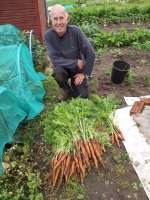Time and Temperature impact the sheer quantity of compost needed in my garden. Between my area and someone in a cooler or drier clime like UK there are differences that can lead to supply problems here because it can leave pretty quickly.
For what it's worth, UK gardeners that promote 'no dig' approach admit that you need to buy in compost. Even bringing in begged and borrowed materials to compost you can't create enough.
From reading between the lines I think the real difference between UK and warmer climates is that we have a massive slug problem. In warm climates composting in place you can just follow nature and drop leaves, cover crops etc on the ground. But in the UK we NEED to use compost else we'll breed millions of slugs.
Meadowlark is growing his own compost (essentially) and composting it in situ. Again, difference in UK is that we tend not to have much land so can't afford to set aside beds in rotation for a cover crop that we can't eat.
I THINK the main difference between what Charles Dowding does and Meadowlark comes down to the UK need to compost first to keep slug numbers down, and lack of available land to grow crops specifically for composting.
Dowding doesn't rotate - he's experimented for several years and found no problems. HOWEVER, he's putting a layer of fresh compost on his beds every year. Also he doesn't think it beneficial to dig in - his experiments show no dig works best than identical amounts of compost dug in.



